When Cheaper is Better: How to Season a Wok
Usually, when you're buying cookware, the rule is this: spend more for better quality. Sure, those big boxed sets of cheap, thin pots and pans at IKEA or Target are tempting, in that pre-packaged, one-stop-shop sort of way: but how good can you really do with pots and pans that average out to $5 a piece? Your sauces will burn, your food will stick, you'll be unable to simmer anything because only a small circle right above the flame will actually heat up. In the end, the thinking goes, your investment in All-Clad or Le Creuset will provide not only better cookware, but it will have a longer lifespan and you'll take better care of it. It reminds me of the line from the late, great comedian Mitch Hedburg : "I bought an 7 dollar pen, 'cause I always lose pens and I got sick of not caring."
It was to my surprise, then, as I was reading about buying a wok, that many say buy the cheapest wok you can find, as long as it's made of carbon steel. Most you see at restaurant supply stores or Asian markets are made out of carbon steel. The idea is, when you're cooking with a wok you'll never be simmering anything over long periods of time. A wok is designed to serve as the quickest possible conduit between the raw flame of the stove and the food you're cooking--the thinner, the better. You want the wok to respond to changes in heat right away, not like a big dinosaur dutch oven that will keep cooking your food for ten minutes after you turn off the heat. The wok should be nimble and quick.
The only catch is this. Like that other well-known bastion of cheap, reliable cookware, the cast iron skillet , a carbon steel wok must be seasoned. You can't take it home from Bed Bath & Beyond and cook a little stir-fry with no oil on your nice, shiny non-stick surface. The wok comes home from the store smelling like steel and machine oil, requires scrubbing and cleaning and burning large quantities of oil over the stove, which will fill your kitchen with oil smoke and turn your wok colors. But you'll only have to do this, in theory, once or twice, and you'll have the personal satisfaction of having created your own homemade nonstick surface made naturally. From then on, the more you cook in the wok the better the seasoned surface becomes, and the less oil you'll have to use. And unlike a teflon commercial non-stick surface, a wok's seasoned surface will begin to add flavor to what you're cooking as it builds up. And you never have to worry about having the heat too high and releasing strange chemicals .
Best of all, the wok should cost about 8 dollars.
How to Season a Wok
First, you have to clean it like there's no tomorrow with hot, soapy water and scouring pads. This is the only time you'll ever use soap to clean your wok, as once you've seasoned it you'll only need water. Mine came with stained metal and machine oil residue, so I took a steel wool Brillo pad to it and scrubbed like crazy, until it was a nice, shiny mirror. Rinse it completely and dry thoroughly.
Next, open all your windows, turn on the hood ventilation, and aim a fan out of your kitchen window. Put the wok on the stove and pour a little oil in the bottom (corn or vegetable). Turn the heat on and let the wok begin to heat.
Almost immediately, the bottom of the wok will begin to turn brown (you'll also see where any hotspots are in the bottom). Tilt the wok constantly to redistribute the oil all over the insides of the pan.
One method is to take a paper towel and tongs to wipe the oil all over the interior surface of the wok, so it's coated. I found, though, that it was better to put more oil in the wok so that you could just tilt it to coat.
At this point, it's just a matter of time. I found I could tilt the pan to coat everything, then relax for a little while and let the thing smoke.
You probably won't have a wok that's completely black by the time you're finished--that only comes after many uses in the kitchen, as the seasoning builds up more and more. I let it cook for about 15 minutes, then turned off the heat and discarded the oil. After it cooled, I started the process all over again. By the time I was finished every part of the wok's inside was discolored in some way: the bottom was darkest, the sides more of a golden orange.
To take care of the wok, you should never use soap or any abrasive scrubbing, which will dislodge the seasoning layer (especially in the early life of the wok). After you cook something, rinse the wok with hot water and, if there are any stubborn food particles sticking, use a paper towel and a couple tablespoons of salt to dislodge it. Rinse thoroughly. In the beginning of a wok's life, a paper towel dipped in oil and rubbed all over the inside of the wok will keep it from rusting.
Seasoning, Uncategorized, Wok

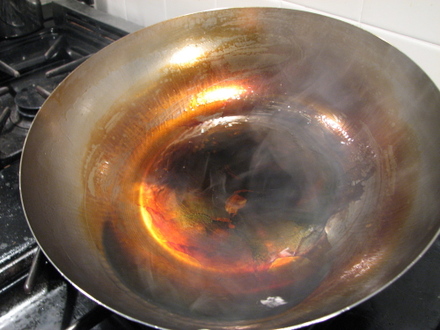
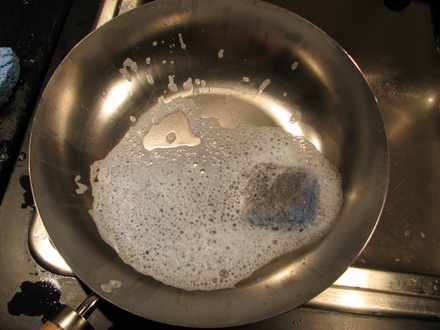
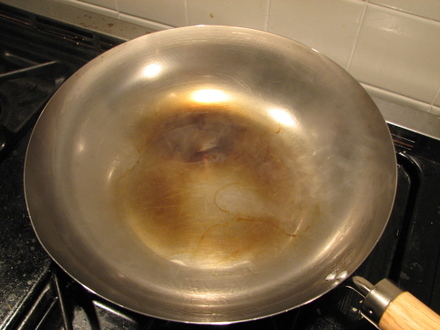
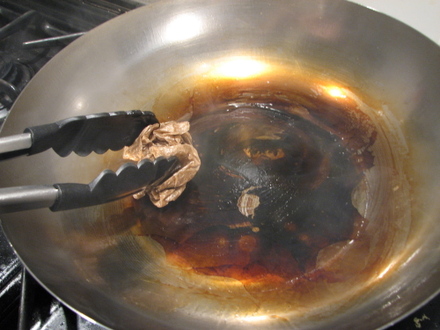
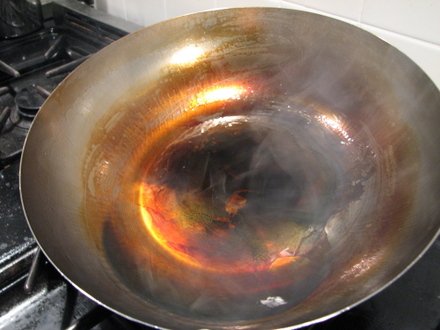
Comments:
Blog Comments powered by Disqus.